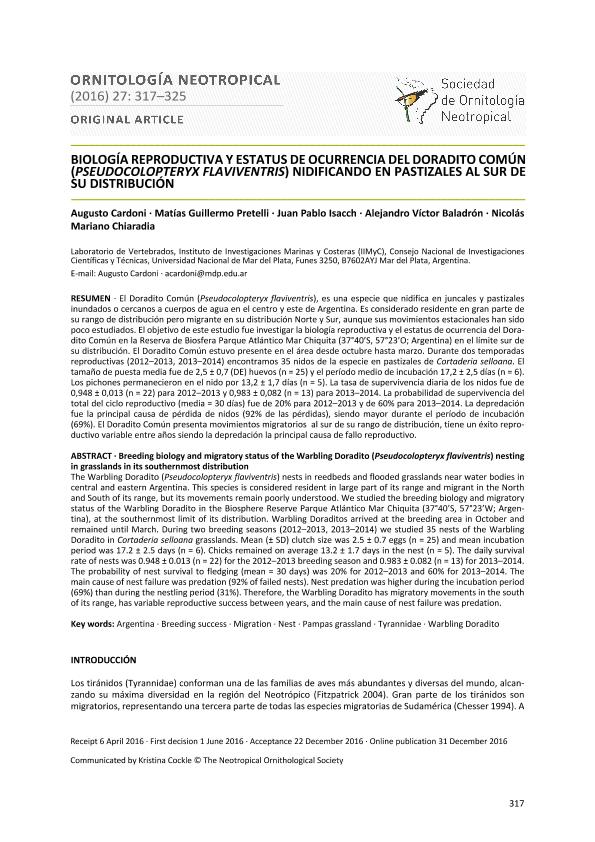Artículo
El Doradito Común (Pseudocolopteryx flaviventris), es una especie que nidifica en juncales y pastizales inundados o cercanos a cuerpos de agua en el centro y este de Argentina. Es considerado residente en gran parte de su rango de distribución pero migrante en su distribución Norte y Sur, aunque sus movimientos estacionales han sido poco estudiados. El objetivo de este estudio fue investigar la biología reproductiva y el estatus de ocurrencia del Dora‐ dito Común en la Reserva de Biosfera Parque Atlántico Mar Chiquita (37°40’S, 57°23’O; Argentina) en el límite sur de su distribución. El Doradito Común estuvo presente en el área desde octubre hasta marzo. Durante dos temporadas reproductivas (2012–2013, 2013–2014) encontramos 35 nidos de la especie en pastizales de Cortaderia selloana. El tamaño de puesta media fue de 2,5 ± 0,7 (DE) huevos (n = 25) y el período medio de incubación 17,2 ± 2,5 días (n = 6). Los pichones permanecieron en el nido por 13,2 ± 1,7 días (n = 5). La tasa de supervivencia diaria de los nidos fue de 0,948 ± 0,013 (n = 22) para 2012–2013 y 0,983 ± 0,082 (n = 13) para 2013–2014. La probabilidad de supervivencia del total del ciclo reproductivo (media = 30 días) fue de 20% para 2012–2013 y de 60% para 2013–2014. La depredación fue la principal causa de pérdida de nidos (92% de las pérdidas), siendo mayor durante el período de incubación (69%). El Doradito Común presenta movimientos migratorios al sur de su rango de distribución, tiene un éxito repro‐ ductivo variable entre años siendo la depredación la principal causa de fallo reproductivo. The Warbling Doradito (Pseudocolopteryx flaviventris) nests in reedbeds and flooded grasslands near water bodies in central and eastern Argentina. This species is considered resident in large part of its range and migrant in the North and South of its range, but its movements remain poorly understood. We studied the breeding biology and migratory status of the Warbling Doradito in the Biosphere Reserve Parque Atlántico Mar Chiquita (37°40’S, 57°23’W; Argen‐ tina), at the southernmost limit of its distribution. Warbling Doraditos arrived at the breeding area in October and remained until March. During two breeding seasons (2012–2013, 2013–2014) we studied 35 nests of the Warbling Doradito in Cortaderia selloana grasslands. Mean (± SD) clutch size was 2.5 ± 0.7 eggs (n = 25) and mean incubation period was 17.2 ± 2.5 days (n = 6). Chicks remained on average 13.2 ± 1.7 days in the nest (n = 5). The daily survival rate of nests was 0.948 ± 0.013 (n = 22) for the 2012–2013 breeding season and 0.983 ± 0.082 (n = 13) for 2013–2014. The probability of nest survival to fledging (mean = 30 days) was 20% for 2012–2013 and 60% for 2013–2014. The main cause of nest failure was predation (92% of failed nests). Nest predation was higher during the incubation period (69%) than during the nestling period (31%). Therefore, the Warbling Doradito has migratory movements in the south of its range, has variable reproductive success between years, and the main cause of nest failure was predation.
Biología reproductiva y estatus de ocurrencia del Doradito común (Pseudocolopteryx Flaviventris) nidificando en pastizales al sur de su distribución
Título:
Breeding biology and migratory status of the Warbling Doradito (Pseudocolopteryx flaviventris) nesting in grasslands in its southernmost distribution
Cardoni, Daniel Augusto ; Pretelli, Matías Guillermo
; Pretelli, Matías Guillermo ; Isacch, Juan Pablo
; Isacch, Juan Pablo ; Baladron Felix, Alejandro Victor
; Baladron Felix, Alejandro Victor ; Chiaradia, Nicolas Mariano
; Chiaradia, Nicolas Mariano
 ; Pretelli, Matías Guillermo
; Pretelli, Matías Guillermo ; Isacch, Juan Pablo
; Isacch, Juan Pablo ; Baladron Felix, Alejandro Victor
; Baladron Felix, Alejandro Victor ; Chiaradia, Nicolas Mariano
; Chiaradia, Nicolas Mariano
Fecha de publicación:
08/2016
Editorial:
Neotropical Ornithological Society
Revista:
Ornitología Neotropical
ISSN:
1075-4377
Idioma:
Español
Tipo de recurso:
Artículo publicado
Clasificación temática:
Resumen
Palabras clave:
Breeding Success
,
Nest
,
Pampas
,
Tyranidae
Archivos asociados
Licencia
Identificadores
Colecciones
Articulos(IIMYC)
Articulos de INSTITUTO DE INVESTIGACIONES MARINAS Y COSTERAS
Articulos de INSTITUTO DE INVESTIGACIONES MARINAS Y COSTERAS
Citación
Cardoni, Daniel Augusto; Pretelli, Matías Guillermo; Isacch, Juan Pablo; Baladron Felix, Alejandro Victor; Chiaradia, Nicolas Mariano; Biología reproductiva y estatus de ocurrencia del Doradito común (Pseudocolopteryx Flaviventris) nidificando en pastizales al sur de su distribución; Neotropical Ornithological Society; Ornitología Neotropical; 27; 8-2016; 317-325
Compartir



